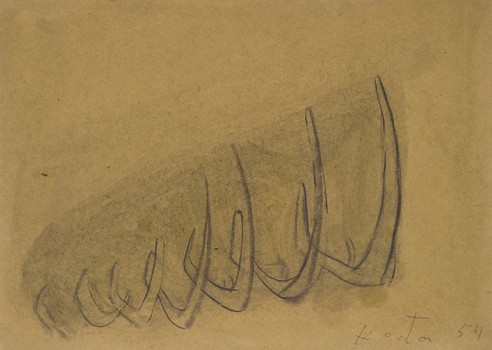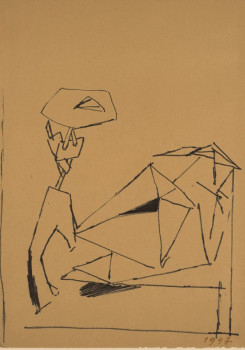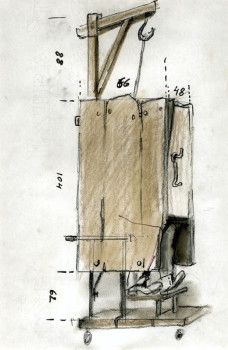
Tadeusz Kantor Let artists perish: accessoire (gallows-closet); 1985
Felt-tip pen, pastel on paper; 27,4 x 18,5 cm (part of the group of 25 drawings)
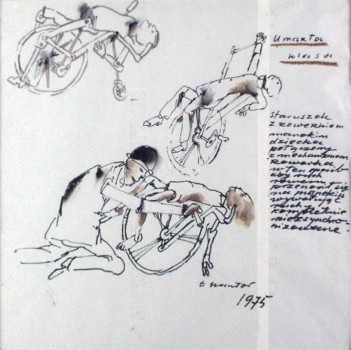
Tadeusz Kantor The Dead Class; 1975
Felt-tip pen, crayon on paper; 27 x 27 cm; (part of the group of 25 drawings)
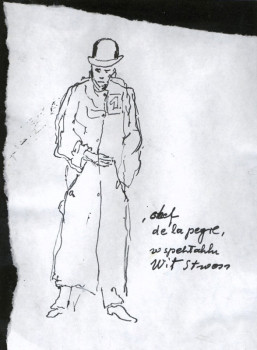
Tadeusz Kantor Untitled; 1970
Collage, felt-tip pen, crayon, pastel on paper; 31,5 x 24,6 cm (part of the group of 25 drawings)
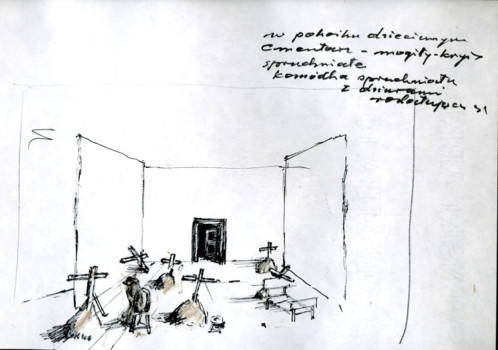
Tadeusz Kantor Let artists perish: chief of underground (Veit Stoss); 1985
Felt-tip pen on paper with disrupted edge; 24,4 x 18,5 cm (part of the group of 25 drawings)
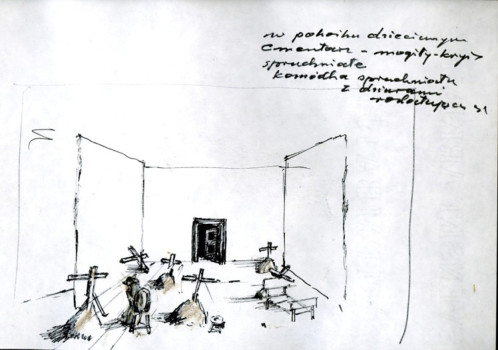
Tadeusz Kantor Let artists perish: my child´s room; 1985
Felt-tip pen and pastel on paper; 21 x 29,7 cm (part of the group of 25 drawings)
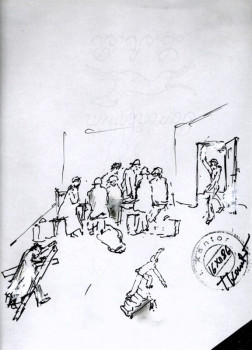
Tadeusz Kantor Let artists perish; 1986
Felt-tip pen, gouache and pastel on paper; 29,7 x 21 cm (part of the group of 25 drawings)

Tadeusz Kantor Let artists perish: sketch of a road; 1985
Felt-tip pen and pastel on paper; 21 x 29,7 cm (part of the group of 25 drawings)
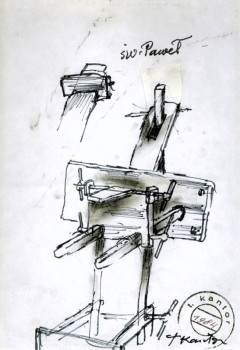
Tadeusz Kantor Let artists perish: pillory I; 1984
Felt-tip pen, pastel and collage on paper; 29,7 x 21 cm (part of the group of 25 drawings)

Tadeusz Kantor Let artists perish: the way, track scene; 1984
Felt-tip pen, pastel and collage on paper; 29,7 x 21 cm (part of the group of 25 drawings)
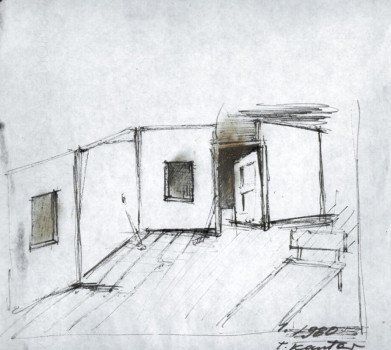
Tadeusz Kantor Wielopole-Wielopole: my child´s room decomposes continuously; 1979
Felt-tip pen and pastel on paper; 19,4 x 20,9 cm (part of the group of 25 drawings)
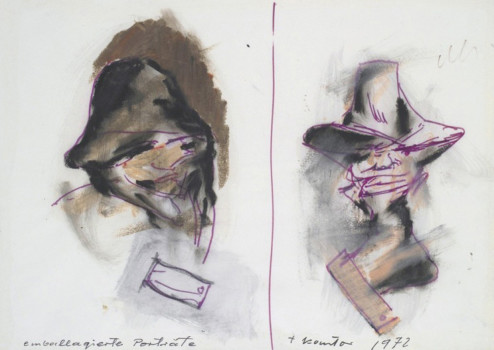
Tadeusz Kantor Portraits – wrapping; 1972
Felt-tip pen, pastel and gouache on paper; 21 x 29,7 cm (part of the group of 25 drawings)
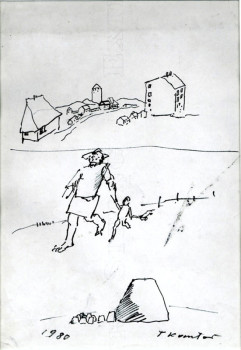
Tadeusz Kantor Untitled; 1980
Black felt-tip pen on paper; 28,7 x 19 cm (part of the group of 25 drawings)
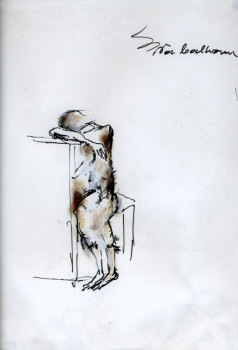
Tadeusz Kantor Untitled; 1988
Felt-tip pen, pastel and gouache on paper; 29,7 x 21 cm (part of the group of 25 drawings)
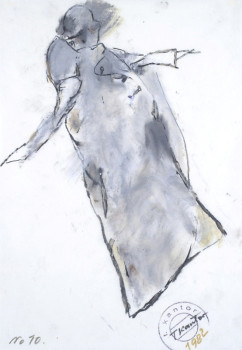
Tadeusz Kantor Tokyo n°10; 1982
Ink, gouache and pastel on tracing paper; 33 x 23,2 cm (part of the group of 25 drawings)
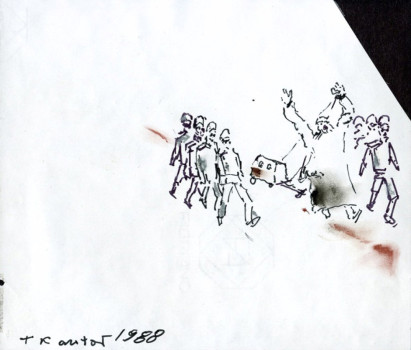
Tadeusz Kantor Untitled; 1988
Black felt-tip pen on paper; 16,5 x 19,4 cm (part of the group of 25 drawings)
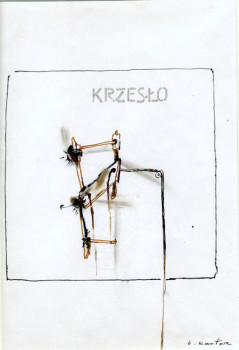
Tadeusz Kantor Everything is hanging by a tread: canvas and pulley; 1973
Felt-tip pen and pastel on paper; 29 x 20,2 cm (part of the group of 25 drawings)
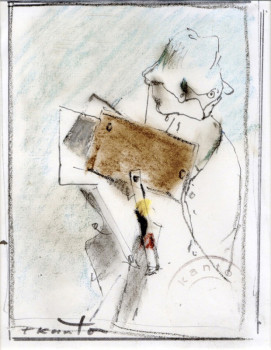
Tadeusz Kantor Portrait – wrapping; 1980
Felt-tip pen and pastel on paper; 19,5 x 16,2 cm (part of the group of 25 drawings)

Tadeusz Kantor Man – coat; 1980
Felt-tip pen and pastel on tracing paper; 29,7 x 21 cm (part of the group of 25 drawings)
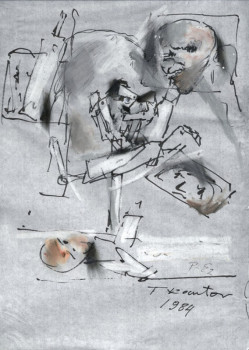
Tadeusz Kantor Heads; 1984
Pastel and felt-tip pen on tracing paper; 29,7 x 21 cm (part of the group of 25 drawings)
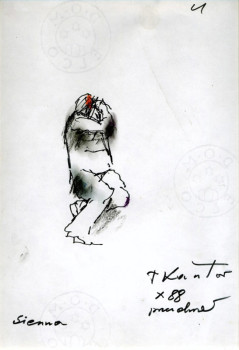
Tadeusz Kantor Sienna – October 88; 1988
Black felt-tip pen, pastel crayon on paper; 29 x 20,5 cm (part of the group of 25 drawings)
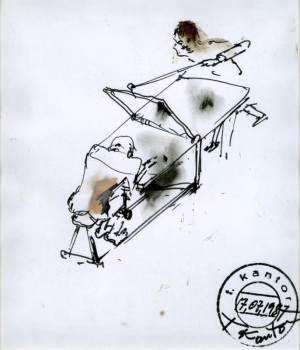
Tadeusz Kantor Monumental mousetrap; 1987
Felt-tip pen and pastel on paper; 29,7 x 21 cm (part of the group of 25 drawings)
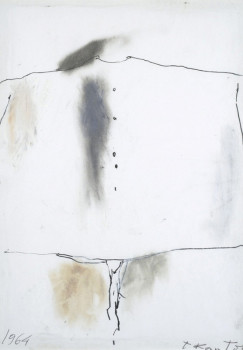
Tadeusz Kantor Clothing – wrapping; 1964
Felt-tip pen and pastel on paper; 29,5 x 21 cm (part of the group of 25 drawings)
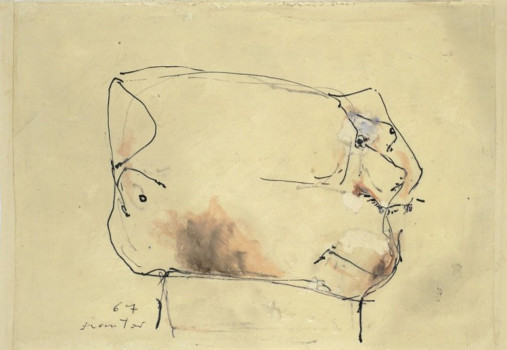
Tadeusz Kantor Portrait wrapped; 1967
Felt-tip pen and pastel on cardboard; 23,5 x 34 cm (part of the group of 25 drawings)
Coming soon
01.02.2014 - 29.03.2014
11.03.2011 - 09.04.2011
1915
born in Wielopole Skrzyńskie, Poland
1990
died in Krakow, Poland
solo exhibitions (selected)
2015
Tadeusz Kantor. Cholernie spadam!, Cricoteka, Cracow, Poland
Inbetween Structures, Summerhall, Edinburgh, Scotland (as a part of Edinburgh Festival Fringe) & Polish Institute, Berlin
Tadeusz Kantor Machine: Theater + happenings + performances + painting + others modes of production, Sesc Consolação, São Paulo, Brazil
2014
Wystawa prac Tadeusza Kantora, Cricoteka, Cracow, Poland
2011
Tadeusz Kantor. Member of the Polish Avant-Garde and Theatre Reformer, Kumu Art Museum, Tallinn, Estonia
Tadeusz Kantor: Drawings, 1947 – 1988, Galerie Isabella Czarnowska, Berlin
2010
homage to tadeusz kantor. a universal vision works on paper 1947-1990, Studio Tommaseo, Istituto per la documentazione e diffusione delle Arti, Trieste, Italy
2009
An Impossible Journey, Sainsbury Centre for Visual Arts, Norwich, England
2008
Tadeusz Kantor, Migros Museum für Gegenwartskunst, Zurich
2005
Tadeusz Kantor, Interior of the Imagination, Zacheta National Gallery of Art, Warsaw
2004
Tadeusz Kantor (1915 – 1990), Mestna Galerija / City Art Gallery Ljubljana, Ljubljana
2003
la classe morta, Galleria 41 artecontemporanea, Turin
Tadeusz Kantor: Umění a paměť (Art and Memory), Czech Museum of Fine Arts, Prague Tadeusz Kantor, Museet for Samtidskunst / Museum of Contemporary Art, Roskilde
2002
Tadeusz Kantor. La Clase Muerta, Sala Verónicas, Murcia
2001
Tadeusz Kantor, Impossible, Ludwig Museum, Köln; Museum of Contemporary Art, Budapest; Centre for Contemporary Art Ujazdowski Castle, Warsaw
2000
Tadeusz Kantor, Ember-állatkert; Platan Gallery; Polish Institute in Budapest, Budapest
1998
Tadeusz Kantor, CEAAC Centre européen d’actions artistiques contemporaines, Strasbourg Tadeusz Kantor, Rysunki z lat 1947-1990, Galeria Miejska Arsenal, Poznan
1976
Tadeusz Kantor, Whitechapel Art Gallery, London
group exhibitions (selected)
2013
The Splendor of Textiles, Zacheta National Gallery of Art, Warsaw
2012
The Freedom of Sound. John Cage behind the Iron Curtain, Ludwig Museum, Köln; Museum of Contemporary Art Budapest, Budapest
Von Kopf bis Fuß – Porträts und Menschenbilder in der Sammlung Würth, Kunsthalle Würth, Schwäbisch Hall
Mediations Biennale 2012 – Mediations Biennale, Poznan
Beuys | Kantor: Remembering, The Israel Museum, Jerusalem
Andrzej Wróblewski, Alina Szapocznikow, Tadeusz Kantor, Galerie Isabella Czarnowska, Berlin
2011
Sztuka cenniejsza niż złoto, Galeria Art NEW media, Warsaw
The Power of Fantasy Modern and Contemporary Art from Poland, National Museum in Kraków, Krakow
The Power of Fantasy – Modern and Contemporary Art from Poland; BOZAR – Palais des Beaux-Arts / Paleis voor Schone Kunsten, Brussels
History in Art, Museum of Contemporary Art in Kraków (MOCAK), Krakow
2010
Fluxus East – Henie Onstad Art Centre, Høvikodden
The Reality of The Lowest Rank – A Vision of Central Europe, curated by Luc Tuymans, Brugge Centraal, Bruges
A Theory of Vision: a Review, Centre for Contemporary Art Ujazdowski Castle, Warsaw
Athens in Catania: Away and Boil your Head selected works from the 1st / 2nd Athens Biennale, Fondazione Puglisi Cosentino, Palazzo Valle, Catania
Things evoke feelings, Centre for Contemporary Art Ujazdowski Castle, Warsaw
… avant il n’y avait rien, après on va pouvoir faire mieux., Circuit, Lausanne
Cameo – – Triple Candie, New York
Über Wut – On Rage, Haus der Kulturen der Welt, Berlin
2009
A Collection. Twenty years of the Starmach Gallery – National Museum in Kraków, Krakow
2nd Athens Biennial 2009 – Heaven, Athens Biennial, Athens
Silences, Musée d’Art Moderne et Contemporain (MAMCS), Strasbourg
Wasser und Wein – Der Katholische Faktor in der zeitgenössischen Kunst, Städtischen Galerie Leerer Beutel, Regensburg
Fluxus East, Kunsthallen Nikolaj, Copenhagen
Fragments. Polish Contemporary art from Muzeum Okregowe in Bydgosz Collection, Wyspa Institute of Art, Gdansk
2008
Fluxus East. Fluxus networks in central eastern Europe – Kumu Art Museum, Tallinn
Peripheral vision and collective body, MUSEION – Museum für moderne und zeitgenössische Kunst, Bolzano
Ad Absurdum, MARTa Herford, Herford
Fluxus East – Fluxus Networks in Central Eastern Europe, Ludwig Museum, Köln; Museum of Contemporary Art Budapest, Budapest
OK! Wyspiański – National Museum in Cracow / Muzeum Narodowe w Krakowie, Krakow
Fluxus East. Fluxus Networks in Central Eastern Europe, Gallery of Contemporary Art Bunkier Sztuki, Krakow
2007
Fluxus East – Contemporary Art Centre (CAC), Vilnius
Dowcip i władza sądzenia. Asteizm w Polsce, Galeria Miejska Arsenal, Poznan
Fluxus East, Künstlerhaus Bethanien, Berlin
Asteism – Joke and authority, Program Gallery, Warsaw
Papiers d’artistes, Galerie Stella & Vega, Brest
MAMIDŁO – Exhibition in 3 Parts, Program Gallery, Warsaw
Raum – Orte der Kunst, Akademie der Künste, Berlin
2006
In Poland, That Is Where?, Centre for Contemporary Art Ujazdowski Castle, Warsaw
Sztuka XX Wieku, The National Museum in Warsaw – The Gallery of 20th-century Polish Art, Warsaw
The Impossible Theatre, Zacheta National Gallery of Art, Warsaw
4. Berlin Biennale für Zeitgenössische Kunst – berlin biennale für zeitgenössische kunst, Berlin
2005
Egocentric, Immoral, Outmoded, Zacheta National Gallery of Art, Warsaw
Das unmögliche Theater – Kunsthalle Wien (Museumsquartier), Vienna
Von Spitzweg bis Baselitz – Streifzüge durch die Sammlung Würth, Museum Würth, Künzelsau
Fifteen Polish Painters, MoMA – Museum of Modern Art, New York City, NY
documenta 2, Documenta, Kassel
2004
Les Trois mousquetaires; Musée des Beaux-Arts de Nancy, Nancy
2003
LOVE/HATE; Ursula Blickle Stiftung, Kraichtal-Unteröwisheim
2001
The Foksal Gallery’s Deposit – Centre for Contemporary Art Ujazdowski Castle, Warsaw
Accrochage, Galerie Inge Baecker, Bad Münstereifel
Tentatives d`évasion I, Galerie de France, Paris
In Between – : Art. From Poland, 1945 – 2000, Chicago Cultural Center, Chicago, IL
2000
Global Conceptualism – Points of Origin, 1950s-1980s – MIT List Visual Arts Center, Cambridge, MA
Aspect – Positions – 50 Years of Art in Central Europe 1949-99, Ludwig Museum, Köln; Museum of Contemporary Art Budapest, Budapest
1999
Global Conceptualism: Points of Origin 1950s–1980s, Queens Museum of Art (QMA), New York
1998
Fluxus und Happening der 60er und 70er Jahre, Galerie Inge Baecker, Bad Münstereifel
1994
Europa, Europa – Das Jahrhundert der Avantgarde in Mittel- und Osteuropa, Kunst- und Ausstellungshalle der Bundesrepublik Deutschland, Bonn
1991
The Interrupted Life, New Museum of Contemporary Art, New York City, NY
1990
Aus der Sammlung, Kunsthalle Nürnberg, Nürnberg
1987
Europalia Oostenrijk, SMAK Stedelijk Museum voor Actuele Kunst, Gent
1982
La Biennale di Venezia : Settore Arti Visive : 1982, La Biennale di Venezia, Venice
1977
documenta 6, Documenta, Kassel
1969
Moderne Polnische Malerei Graphil, Neue Nationalgalerie, Berlin
Das 2,3-Millionen-Euro-Bild by Kölner Stadt-Anzeiger
Es sind die Facetten, die den Kunstmarkt schillern lassen. Ihren ersten euphorisch stimmenden Erfolg haben die Art Cologne und insbesondere der Kölner Aussteller Klaus Benden bereits gefeiert: Für satte 2,3 Millionen Euro wechselte an seinem Stand ein Bild von Tom Wesselmann den Besitzer: „Smoker #2 (3D)“ von 1999. Der Käufer, ein rheinischer Sammler, hatte eben dieses charmante Werk
...read more on
Galerieprofil Isabella Czarnowska - Mir liegt die Art so zu denken by Julika Nehb
Nach Stationen in Stuttgart und Köln Mitte der 1980er Jahre führt Isabella Czarnowska seit 2006 unter ihrem Namen ihre Galerie in der Rudi-Dutschke-Straße. Mit 18 Jahren war sie von Polen nach Stuttgart zum Kunstgeschichtsstudium gekommen – an der Fakultät saßen Geisteswissenschaftler mit Studenten der Akademie der Künste in gemeinsamen Veranstaltungen. Wichtige Begegnungen mit Künstlern ergaben sich während einer Romantikvorlesung mit Jean-Pierre Dubost.
...read more on
Mit Internationalität punkten: ART COLOGNE 2011 by Rheinische Art
Die ART COLOGNE, Kunstmesse mit einer bedeutenden Vergangenheit und einer wie es scheint sehr guten Zukunft, überzeugt mit sorgfältig kuratierten Präsentationen. Die rund 200 beteiligten Galerien kommen aus 22 Ländern. Die Ausstellung hebt sich wieder als einen bedeutenden Ort der Begegnung der europäischen Kunstszene hervor. Ob sie auch ihren Ruf als Bühne der (Kunst)Revolutionen aufgreifen konnte, wird sich später zeigen. Die Voraussetzungen sind jedenfalls gegeben: Das Interesse ist
...read more on
Luc Tuymans curates: A Vision of Central Europe by PHAIDON
It has been suggested that, for a city with such a rich heritage, Bruges has few dedicated art institutions. But what the city lacks in permanent galleries – primarily those concerned with contemporary art – it has more than made up for with its recent series of highly successful
...read more on
Catalogues
Chrobak, Józef and Justyna Michalik (ed.), Tadeusz Kantor Od „Małego dworku” do „Umarłej klasy” / From The „Country House” to „The Dead Class”. Cricoteka, Muzeum Narodowe we Wrocławiu, Kraków 2010.
Halczak, Anna (ed.), Tadeusz Kantor. Epoka chłopca/Tadeusz Kantor. Boyhood Epoch. Cricoteka, Kraków 2008.
Halczak, Anna (ed.), Fotografie Jacquie Bablet/Photographies de Jacquie Bablet [Photographies by Jacquie Bablet]. Cricoteka, Kraków 2008.
Tadeusz Kantor. Migros Museum für Gegenwartskunst, Zürich 2008.
Chrobak, Józef and Katarzyna Ramut (ed.), Tadeusz Kantor. Między kościołem a synagogą (szkic o pamięci) [Tadeusz Kantor. Between the church and the synagogue (sketch about the memory)]. Galeria Współczesnej Sztuki Sakralnej w Kielcach, Kielce 2007.
Chrobak, Józef and Marek Wilk (ed.), Tadeusz Kantor i WSSP w Krakowie 1947-1950[Tadeusz Kantor and WSSP in Cracow in the Years 1947-1950]. Galeria Krzysztofory, Kraków 2007.
Chrobak, Józef (ed.), Wojtek Sperl. Fotografie z seansu Tadeusza Kantora „Umarła klasa” 1975-1976 [Wojtek Sperl. Photos from the performance „The Dead Class” by Tadeusz Kantor 1975-1976]. Cricoteka, Kraków 2007.
Teatr niemożliwy. Performatywność w sztuce Pawła Althamera, Tadeusza Kantora, Katarzyny Kozyry, Roberta Kuśmirowskiego i Artura Żmijewskiego. / The Impossible Theatre. Performativity in the Works of Paweł Althamer, Tadeusz Kantor, Katarzyna Kozyra, Robert Kuśmirowski and Artur Żmijewski, Kunsthalle Wien, Zachęta National Gallery of Art Warsaw, Vienna / Warszawa 2006.
Kantor en Rhône-Alpes, Valence , Lyon 2006.
Suchan, Jarosław and Marek Świca (ed.), Tadeusz Kantor. Interior imaginacji / Interior of Imagination. Zachęta National Gallery of Art, Centre for the Documentation of the Art of Tadeusz Kantor Cricoteka, Warszawa / Kraków 2005.
Halczak, Anna (text) and Konopka, Agnieszka (ed.), Ośrodek Teatru Cricot 2 – Cricoteka[Cricoteka – Cricot 2 Theatre Centre]. Biblioteka Narodowa, Warszawa 2005.
Paluch-Cybulska, Małgorzata, Pejzaż w twórczości malarskiej i rysunkowej Tadeusza Kantora [Landscape in Tadeusz Kantor’s Paintings and Drawings]. Kraków 2005.
Turowski, Andrzej, “Fin des temps! – l’histoire n’est plus” – L’art polonais du 20e siecle. Hôtel des Arts, Toulon 2004.
Flik-Fizek, Małgorzata, Święci rewolucji. Maria Jarema, Tadeusz Kantor [Saints of the Revolution. Maria Jarema, Tadeusz Kantor]. Galeria Fizek, Poznań 2004.
Svetina, Ivo, Tadeusz Kantor. Njegovo gledalisce in slokarstvo. Slovenski gledaliski muzej, Mestna galerija, Ljubljana 2004.
Tadeusz Kantor – Umarła Klasa [Tadeusz Kantor – The Dead Class]. Państwowa Galeria Sztuki, Sopot 2004.
Walczak-Andersen, Ewa and Tine Seligmann (ed.), Tadeusz Kantor. Tegningens rum – Det mentale rum (Cambriolage). Museet for Samtidskunst, Roskilde 2003.
Drury, Richard, Tadeusz Kantor. Umení a pamet. Art and memory. The Czech Museum of Fine Arts, Prague 2003.
Chrobak, Józef and Natalia Zarzecka (ed.), “Gdzie są niegdysiejsze śniegi” – Cricotage Tadeusza Kantora. 25 lat później [“Where Are Last Year’s Snows” – Tadeusz Kantor’s Cricotage. 25 Years Later]. Galeria Krzysztofory, Kraków 2003.
Tadeusz Kantor z “Wielopola, Wielopola” [Tadeusz Kantor from “Wielopole, Wielopole”]. Galeria Foksal, Warszawa 2003.
Halczak, Anna (ed.), Tadeusz Kantor. Kolekcja “A” [Tadeusz Kantor. The ‘A’ Collection] Cricoteka, Galeria Sztuki w Legnicy, Kraków 2003.
Saciuk-Gąsowska, Anna (ed.), Tadeusz Kantor. Rysunki z kolekcji Muzeum Sztuki w Łodzi[Tadeusz Kantor. Drawings from the Collection of the Muzeum Sztuki in Łódź]. Miejska Galeria Sztuki, Galeria Willa, 2001; Galeria Bielska BWA, Łódź / Bielsko-Biała 2002.
Chrobak, Józef and Carlo Sisi (ed.), Tadeusz Kantor. Dipinti, disegni, teatro. Galleria d’Arte Moderna, Palazzo Pitti, Firenze 2002.
Tejeda, Isabel and Grzegorz Musiał (ed.), Tadeusz Kantor. La clase muerta [The Dead Class]. Iglesia de Veronicas, Murcia 2002.
Kunowska, Jolanta (ed.), Balladyna według Kantora [Balladyna According to Kantor]. Cricoteka, Kraków 2002.
Świca, Marek and Józef Chrobak (ed.), Nowocześni a socrealizm [Social Realism and the Modern Artist]. Starmach Gallery, Kraków 2000.
Cieślińska-Lobkowicz, Nawojka, Verteidigung der Moderne Positionen der Polnischen Kunst nach 1945. Museum Würth, Künzeslau 2000.
Gołubiew, Zofia (ed.), “Mam wam coś do powiedzenia”. Tadeusz Kantor – autoportrety [“I Have Something to Tell You”. Tadeusz Kantor – Self-portraits]. National Museum, Kraków 2000.
Niechoda, Małgorzata-Daria (ed.), Tadeusz Kantor. Informel. Starmach Gallery, Kraków 1999.
Gołubiew, Zofia, Kantor. Motywy hiszpańskie [Kantor. Spanish Motifs]. National Museum, Kraków 1999.
Pleśniarowicz, Krzysztof (ed.), Tadeusz Kantor. Klisze pamięci [Tadeusz Kantor. Negatives of Memory]. Rundetaarn, Kopenhagen 1999.
Świca, Marek and Józef Chrobak (ed.), I Wystawa Sztuki Nowoczesnej. Pięćdziesiąt lat później [Ist Exhibition of Modern Art. Fifty Years Later]. Starmach Gallery, Kraków 1998.
Skipp, Tom (ed.), Tadeusz Kantor. La scena de la memoria. Madrid – Barcelona 1997.
Musiał, Grzegorz (ed.), Tadeusz Kantor. Rysunki z lat 1947-1990 [Tadeusz Kantor. Drawings from the Years 1947-1990]. Gallery 86, Łódź 1997.
Jedliński, Jaromir (ed.), Tadeusz Kantor 1915-1990. Leben im Werk. Kunsthalle Nürnberg, Nürnberg 1996.
Stangret, Lech (ed.), Kantor. Fantomy Realności [Kantor. Phantoms of Reality]. Centrum Scenografii Polskiej, Katowice 1995.
Rostworowski, Marek (ed.), “Tańczyli na moście” wiek cały [“They Danced On the Bridge” All Century Long]. Arsenał, Kraków 1995.
Pleśniarowicz, Krzysztof (ed.), Tadeusz Kantor. Klasa Szkolna – Dzieło Zamknięte / The Classroom – Closed Work. Cricoteka, Kraków 1995.
Shigemi, Oka and Suzuki Takashi (ed.), Tadeusz Kantor. My Creation, My Journey, Sezon Museum of Art, Tokyo 1994; Itami City Museum of Art, Hyogo 1995.
Pleśniarowicz, Krzysztof (ed.), Tadeusz Kantor “Powrót Odysa”. Podziemny Teatr Niezależny /”The Return of Odysseus”. The Clandestine Independent Theatre 1944. Cricoteka, Kraków 1994.
Rostkowska, Teresa (ed.), Grupa Krakowska 1932-1994 [The Cracow Group 1932-1994]. Zachęta National Gallery of Art, Warszawa 1994.
Litak, Anna and Grzegorz Niziołek (ed.), Labirynt zwany Teatr [The Labyrinth called Theatre]. Galeria BWA, Kraków 1994.
Ergino, Nathalie, Tadeusz Kantor. Musée d’Art Contemporain de Nîmes, Nîmes 1991.
Gołubiew, Zofia (ed.), Tadeusz Kantor. Malarstwo i rzeźba [Tadeusz Kantor. Painting and Sculpture]. National Museum, Kraków 1991.
Halczak, Anna and Krzysztof Pleśniarowicz (ed.), Tadeusz Kantor. Przedmioty, klisze pamięci… [Tadeusz Kantor. Objects, Negatives of Memory…]. BWA, Wrocław 1990.
Kantor, peintures, dessins. Centre d’Arts Contemporains, Orléans 1990.
Tadeusz Kantor. Plus Loin, Rien!. Galerie de France, Paris 1989.
Ryba, Ludmiła (ed.), Oggetti e macchine del teatro di Tadeusz Kantor. Museo internazionale delle marionette, Palermo 1987.
La Troupe Cricot 2 et son Avant-garde. Centre Georges Pompidou, Paris 1983.
Le opere di Tadeusz Kantor i pittori di Cricot 2…, Palazzo Reale, Milan 1979.
Rembrandt-Preis 1978 an Tadeusz Kantor, Krakau 1978, Johann Wolfgang von Goethe-Stiftung. Basel 1978.
Tadeusz Kantor. Ambalaże [Emballages]. Galeria Foksal, Warszawa 1976.
Tadeusz Kantor. Emballages 1960-76. Whitechapel Art Gallery, London 1976.
Tadeusz Kantor. Umbrella. Richard Demarco Gallery, Edinburgh 1972.
T. Kantor. Rezerwat Ludzki / Human Reservation. Galeria Desa, Kraków 1975.
Tadeusz Kantor. Wszystko wisi na włosku [Everything Is Hanging by a Thread]. Galeria Foksal, Warszawa 1973.
Tadeusz Kantor. La Chaise. Stolen. Henie Onstad Kunstsenter, Oslo 1971.
Tadeusz Kantor. Happening “Hommage a Maria Jarema”, Galeria Krzysztofory, Kraków 1968.
Ptaszkowska, Hanna (ed.), T. Kantor. Panoramiczny happening morski [Tadeusz Kantor’s Panoramic Sea Happening], Łazy k. Osiek (part of the V Koszalin Outdoor Session). Koszalińskie Towarzystwo Społeczno-Kulturalne, Koszalin 1967.
Tadeusz Kantor. Happening “List” [Happening “Letter”]. Galeria Foksal, Warszawa 1967.
Tadeusz Kantor. Staatliche Kunsthalle, Baden-Baden 1966.
Kantor, peintures recentes. Galerie de L’Université A.G., Paris 1966.
Kantor. Galerie Alice Pauli, Lausanne 1964.
Hering, Karl Heinz and Ewald Rathke (ed.), Tadeusz Kantor. Düsseldorf Kunsthalle Grabbeplatz, Düsseldorf 1959.
Book publishings of texts by the artist
Pleśniarowicz, Krzysztof (ed.), Kantor, Tadeusz. Metamorfozy. Teksty o latach 1934-1974. [Metamorphoses. Texts about the years 1938-1974], Vol. 1. Ossolineum, Cricoteka, Kraków 2005.
Pleśniarowicz, Krzysztof (ed.), Kantor, Tadeusz. Dalej już nic… Teksty z lat 1985-1990 . [Further On, Nothing… Texts from the years 1985-1990], Vol. 3. Ossolineum, Cricoteka, Kraków 2005.
Pleśniarowicz, Krzysztof (ed.), Tadeusz Kantor. Teatr Śmierci. Teksty z lat 1975-1984. [The Theatre of Death. Texts from the years 1975-1984], Vol. 2. Ossolineum, Cricoteka, Kraków 2004.
Marinelli, Luigi and Silvia Parlagreco (ed.), La classe morta de Tadeusz Kantor. Libri Scheiwiller, Milan 2003.
Pleśniarowicz, Krzysztof (ed.), Metamorfozy. Teksty o latach 1938-1974 [Metamorphoses. Texts on the Years 1938 – 1974]. Ośrodek Dokumentacji Sztuki Tadeusza Kantora Cricoteka, Księgarnia Akademicka, Kraków 2000.
Király, Nina (ed.), Halászínház. Prospero Könyvek, Budapest – Szeged 1994.
Kobialka, Michal (ed.), A Journey Through Other Spaces. Essays and Manifestos, 1944-1990 Tadeusz Kantor. University of California Press, Berkeley/Los Angeles/London 1993.
Lekcje mediolańskie. Cricoteka, Biuro Kongresowe Urzędu Miasta Krakowa, Kraków 1991.
Het Circus van de Dood. International Theatre & Film Books, Amsterdam 1991.
Ma création. Mon voyage. Commentaires intimes. Editions Plume, Paris 1991.
La mia opera. Il mio viaggio. Commento intimo. Federico Motta Editore S.p.A., Milan 1991.
Leçons de Milan. Actes Sud – Papiers, Paris 1990.
Kantor, Tadeusz, Wielopole, Wielopole. Marion Boyars, London 1990.
Otori, Hidenaga (ed.), [Let the Artists Die]. Sakuhinsa, Tokyo 1990.
Nawrocki, Piotr, Heinz Neidel and Manfred Rothenberger (ed.), Ein Reisender – seine Texte und Manifeste. Verlag für moderne Kunst, Nürnberg 1988.
Lezioni milanesi. [The Milano Lessons]. Ubulibri, Milan 1988.
Bablet, Denis (ed.), El teatro de la muerte. Ediciones de la Flor, Buenos Aires 1984.
Bablet, Denis (ed.), Le théâtre de la mort. Parco Picture Backs, Tokyo 1982.
Metamorphoses. Chene/Hachette – Galerie de France, Paris 1982.
Bablet, Denis (ed.), Il teatro della morte. Ubulibri, Milan 1979, 2000.
Bablet, Denis (ed.), Le théâtre de la mort. [The Theatre of Death], L’Age d’Homme, Lausanne 1977, 1985.
Books
Palazzi, Renato, Kantor. La materia e l’anima. Pisa: Titivillus, 2010.
Kobialka, Michal, O Călătorie în alte spaţii. Teatrul lui Tadeusz Kantor. Cluj-Napoca: Casa Casa Cărţii de Ştiinţă, 2010.
Czerska, Karolina, Józef Chrobak and Justyna Michalik (ed.), „Les Cordonniers” de Tadeusz Kantor / „Szewcy” Tadeusza Kantora [„Shoemakers” by Tadeusz Kantor]. Kraków: Cricoteka 2010.
Chrobak, Józef and Justyna Michalik (ed.), Tadeusz Kantor nad morzem [Tadeusz Kantor at the seaside]. Cricoteka, Teatr Miejski im. Witolda Gombrowicza w Gdyni, Kraków 2009 (accompanys to exhibition Tadeusz Kantor at the seaside).
Halczak, Anna (elab.), Galeria – Pracownia Tadeusza Kantora. Cricoteka [Gallery – Atelier of Tadeusz Kantor. Cricoteka]. Cricoteka, Kraków 2009 (accompanys to exhibitionTadeusz Kantor – paintings and drawings from 1987-1990).
Kobialka, Michal, Further on, nothing. Tadeusz Kantor’s Theatre. University of Minnesota Press, Minneapolis, London 2009 (includes texts by Tadeusz Kantor).
Chrobak, Józef and Justyna Michalik (ed.), W Tarnowie i Krakowie. Szkolne lata Tadeusza Kantora 1924-1939 wraz z uzupełnieniami do roku 1944 [In Tarnów and Krakow. Tadeusz Kantor’s Schol Years 1924-1939 (including annex till 1944)]. Cricoteka, Kraków 2009.
Chrobak, Józef and Justyna Michalik (ed.), Tadeusz Kantor i Artyści Teatru Cricot 2 (Dokumenty i materiały) cz. I [Tadeusz Kantor and the Artists of Cricot 2 Theatre (documents and materials) Vol. I.]. Cricoteka, Kraków 2009.
Chrobak, Józef and Marek Wilk (ed.), Cricot 2 – lata 50., Tadeusz Kantor i początki Teatru Cricot 2, 1955-1958 [Cricot 2 –the fifties. Tadeusz Kantor and the beggining of Cricot 2 Theatre, 1955-1958]. Cricoteka, Kraków 2008.
Święcicki, Klaudiusz, Historia w teatrze Tadeusza Kantora [History In Tadeusz Kantor’s Theatre]. Wydawnictwo Poznańskie, Poznań 2007.
Pleśniarowicz, Krzysztof, A Halott Emlékek Gépezete. Tadeusz Kantor Halálszínháza. Budapest 2007.
Chrobak, Józef and Natalia Zarzecka (ed.), Kantor. Wielopole, Wielopole. Dossier. Ośrodek Dokumentacji Sztuki Tadeusza Kantora Cricoteka, Kraków 2007.
Getta, Lido (elab.) and Silvia Parlagreco (ed.), Protagonismo registico e spazio memoriale. Titivillus Edizioni, Pisa 2007.
Schorlemmer, Uta (ed.), Kunst ist ein Verbrechen. Tadeusz Kantor, Deutschland und die Schweiz. Verlag für moderne Kunst / Cricoteka, Nürnberg / Kraków 2007.
Schorlemmer, Uta (ed.), Sztuka jest przestępstwem. Tadeusz Kantor a Niemcy i Szwajcaria [Art is crime. Tadeusz Kantor to Germany and Switzerland]. Verlag für moderne Kunst / Cricoteka, Nürnberg / Kraków 2007.
Chrobak, Józef, Katarzyna Ramut, Tomasz Tomaszewski and Marek Wilk (ed.), Kunstgewerbeschule 1939-1943 i Podziemny Teatr Niezależny Tadeusza Kantora w latach 1942-1944 [Kunstgewerbeschule 1939-1943 and the Clandestine Independent Theatre of Tadeusz Kantor in the Years 1942-1944]. Cricoteka, Kraków 2007.
Halczak, Anna and Bogdan Renczyński, Tadeusz Kantor. Obiekty/przedmioty. Zbiory Cricoteki. Katalog prac [Tadeusz Kantor. Objects. Cricoteka Collection. A catalogue]. Cricoteka, Kraków 2007.
Chrobak, Józef, Michał Rogalski and Marek Wilk (ed.), Panoramiczny happening morski i Tadeusz Kantor w latach 1964-1968 [Panoramic Sea Happening and Tadeusz Kantor in the Years 1942-1944]. Cricoteka, Kraków 2007.
Paluch-Cybulska, Małgorzata (ed.), Tadeusz Kantor. Scenografie dla “teatrów oficjalnych”, katalog prac [Tadeusz Kantor. Stage Designs for “Official Theatres”. A Catalogue]. Centre for the Documentation of the Art of Tadeusz Kantor Cricoteka, Kraków 2006.
Stangret, Lech, Tadeusz Kantor. Malarski ambalaż totalnego dzieła [Tadeusz Kantor. Painting Emballage of a Total Masterpiece]. Art + Edition, Kraków 2006.
Pieniążek, Marek, Akt twórczy jako mimesis. “Dziś są moje urodziny” – ostatni spektakl Tadeusza Kantora [Act of Creation as a Mimesis. ‘Today Is My Birthday’ – the Last Performance by Tadeusz Kantor.]. Universitas, Kraków 2005.
Schorlemmer, Uta, Tadeusz Kantor. Er War Sein Theater. Verlag für moderne Kunst, Nürnberg 2005.
Chrobak, Józef (ed.), Wielopole Skrzyńskie di Tadeusz Kantor. Cricoteka, Kraków 2005.
Chrobak, Józef, Ewa Kulka and Tomasz Tomaszewski (ed.), “Powrót Odysa” i Podziemny Teatr Niezależny Tadeusza Kantora w latach 1942-1944 [“The Return of Oddysseus” and the Clandestine Independent Theatre of Tadeusz Kantor in the Years 1942-1944] part 1. Cricoteka, Kraków 2004.
Baran, Zbigniew (idea and ed.), Pierścień “Balladyny”. Gra z Teatrem Podziemnym Tadeusza Kantora [Balladyna’s Ring. Playing with Tadeusz Kantor’s Clandestine Theatre]. Cricoteka, Kraków 2003.
Halczak, Anna (ed.), Tadeusz Kantor. Zbiory publiczne, katalog prac [Tadeusz Kantor. Public Collections, a catalogue]. Cricoteka, Kraków 2003.
Amey, Claude, Tadeusz Kantor. Theatrum Litteralis. L’Harmattan, Paris 2002.
Memorie del teatro. Biblioteca Spadoni, Titivillus Edizioni, Firenze 2002. Parts: 1. Chrobak, Józef (ed.), Il viaggio di Tadeusz Kantor (compendio biografico). 2. Arpini, Luigi (ed.), L’illusione vissuta. Viaggi e teatro con Tadeusz Kantor. 3. Valoriani, Valerio (ed.), Kantor a Firenze.
Święcicki, Klaudiusz, Małe ojczyzny Europy w teatrze Tadeusza Kantora [Small Homelands of Europe in Tadeusz Kantor’s Theatre]. Cricoteka, Collegium Europaeum Gnesnese, Kraków / Gniezno 2002.
Buscarino, Maurizio, Kantor. Leonardo Arte, Milan 2001.
Kott, Jan, Kaddish. Pagine su Tadeusz Kantor. Libri Scheiwiller, Milan 2001.
Suchan, Jarosław (ed.), Tadeusz Kantor Lehetetlen / Impossible. Ludwig Múzeum, Kortárs Múvészeti Múzeum, Budapest 2001.
Martinis, Romano, Tadeusz Kantor – Cricot 2. Oedipus Edizioni, Milan 2001 (includes texts by Tadeusz Kantor).
Kott, Jan, Kaddish. Pages sur Tadeusz Kantor. LE PASSEUR – Cecofop, Nantes 2000.
Kott, Jan, Kaddish. Publisher Michitani, Tokyo 2000.
Scarpetta, Guy, Kantor au présent. Actes Sud, Paris 2000.
Suchan, Jarosław (ed.), Tadeusz Kantor. Niemożliwe / Impossible. Bunkier Sztuki Galeria Sztuki Współczesnej, Kraków 2000.
Chrobak, Józef, Lech Stangret and Marek Świca, Tadeusz Kantor. Wędrówka [Tadeusz Kantor. A journey]. Cricoteka, Kraków 2000.
Pleśniarowicz, Krzysztof (ed.), Hommage a Tadeusz Kantor. Kraków: Cricoteka, Uniwersytet Jagielloński, Académie Expérimentale des Théâtres, 1999.
Tadeusz Kantor, Motywy hiszpańskie / Motivos espanoles [Tadeusz Kantor. Spanish Motives]. Warszawa: Instytut Cervantesa, 1999.
Jurkiewicz, Małgorzata, Joanna Mytkowska and Andrzej Przywara (ed.), Tadeusz Kantor. Z Archiwum Galerii Foksal [Tadeusz Kantor. From the Foksal Gallery Archives]. Galeria Foksal SBWA, Fundacja Galerii Foksal, Warszawa 1998.
Wiewiora, Dietmar, Materie, kollektive Erinnerung und individuelle Existenz im Theatre von Tadeusz Kantor (1938-1991). Universitas, Kraków 1998.
Buscarino, Maurizio and Roberta Valtorta (ed.), Kantor, cyrk śmierci [Kantor. Circus of Death]. Edition Sturzfluge, Bozen 1997.
Kott, Jan, Kadysz. Strony o Tadeuszu Kantorze [Kaddish. Pages about Tadeusz Kantor].słowo/obraz terytoria, Gdańsk 1997, 2005.
Pleśniarowicz, Krzysztof, Kantor. Artysta końca wieku [Kantor. Artist of the End of the Century.] Wydawnictwo Dolnośląskie, Wrocław 1997.
Porębski, Mieczysław, Deska [Plank]. Wydawnictwo Murator, Warszawa 1997.
Gryglewicz, Tomasz (ed.), W cieniu krzesła. Malarstwo i sztuka przedmiotu Tadeusza Kantora [In the Shadow of the Chair. Painting and the Art of the Object of Tadeusz Kantor]. Universitas, Kraków 1997.
Fergombe, Amos Passing, Tadeusz Kantor, de l’écriture scénique de la mort a l’instauration de la mémoire. Presse Universitaire de Valenciennes, Valencienne 1997.
Porębski, Mieczysław, “Rozmowy” [Conversations], in: Deska. Wydawnictwo Murator, Warszawa 1997.
Eruli, Brunella, Tadeusz Kantor. Entretiens. Editions Carré Arts & Estétique, Paris 1996.
Resenzvaig, Marcos, El teatro de Tadeusz Kantor. Leviatan, Buenos Aires 1995.
Skiba-Lickel, Aldona, Aktor według Kantora [The Actor According to Kantor]. Zakład Narodowy im. Ossolińskich – Wydawnictwo, Wrocław 1995.
Pleśniarowicz, Krzysztof, The Dead Memory Machine. Tadeusz Kantor’s Theatre of Death. Ośrodek Dokumentacji Sztuki Tadeusza Kantora Cricoteka, Kraków 1994.
Pleśniarowicz, Krzysztof, Teatr nie-ludzkiej formy [Theatre of Un-Human Form]. Universitas, Kraków 1994.
Nowaczyk, Włodzimierz (ed.), Dzieła Tadeusza Kantora w Kolekcji Muzeum Narodowego w Poznaniu [Tadeusz Kantor’s works in the Collection of the National Museum in Poznań, paintings and works on paper catalogue]. Muzeum Narodowe, Poznań 1993.
Bablet, Denis (ed.), Kantor 2. Les Voies de la création théâtrale 18, Éditions de Centre National de la Recherche scientifique, Paris 1993.
Kłossowicz, Jan, Tadeusz Kantor. Theater. Państwowy Instytut Wydawniczy, Warszawa 1991; Kłossowicz, Jan and Harald Xander (ed.), Tadeusz Kantors Theatre. A. Francke Verlag, Tübingen / Basel 1995.
Rose, Caroline, Tadeusz Kantor. Miroirs, Maubeuge 1991.
Banu, Georges (ed.), Kantor, l’artiste a la fin du XXeme siecle. Paris: Actes Sud – Papiers, 1990.
Ô douce nuit. Les Classes d’Avignon. Actes Sud – Papiers, Paris 1990.
Pleśniarowicz, Krzysztof, Teatr Śmierci Tadeusza Kantora [Tadeusz Kantor’s Theatre of Death]. VERBA, Chotomów 1990.
Miklaszewski, Krzysztof, “Spotkania z Tadeuszem Kantorem” [Meetings with Tadeusz Kantor]. Krajowa Agencja Wydawnicza, Kraków 1989; TKECh, Kraków 1992; Mexico 2001; Routledge, New York 2005.
Kühnel, Günther K (phot.). Tadeusz Kantor: Theatre des Todes. Die tote Klasse. Wielopole – Wielopole. Zirndorf, Nürnberg: Verlag für moderne Kunst, 1983 (includes texts by Tadeusz Kantor).
Bablet, Denis (ed.), T. Kantor. Les Voies de la création théâtrale XI, Éditions de Centre National de la Recherche scientifique, Paris 1983, 1990.
Borowski, Wiesław, Tadeusz Kantor. Wydawnictwa Artystyczne i Filmowe, Warszawa 1982.
Martinis, Romano, Cricot 2, Immagine di un teatro. Le Parole Gelate, Rome 1982.
Buscarino, Maurizio, La classe morta di Tadeusz Kantor. Universale Economica Feltrinelli, Milan 1981.
Articles and Interviews
Maślińska, Irena, “L’art est un délit” / “Art Is Crime.” Le Théâtre en Pologne / The Theatre in Poland, no. 1, 1991.
Banu, Georges, “Testament et amour.” Alternatives Théâtrales, no. 37, 1991.
Scarpetta, Guy, “Ce qu’ils appellent la liberté.” La Regle du jeu, May 1990 (1).
Toshimitsu, Tetsuo, Interview with Tadeusz Kantor, Theatre, June 1990 (Japan).
Yomota, Inuhiko, To Leave and Return Talk with Tadeusz Kantor, Bungakukai, July 1990 (Japan).
Maślińska, Irena, “Sztuka jest przestępstwem” [Art Is Crime]. Polityka, no. 35, 1990.
Duvignaud, Jean and Françoise Gründ, “Tadeusz Kantor. Réponses a onze questions.” Internationale de l’Imaginaire, Spring 1989.
Matynia, Andrzej, “O fotografii z Tadeuszem Kantorem/Tadeusz Kantor on photography.” Projekt, no. 3, 1987.
Kobialka, Michal, “Let the Artists Die?” TDR/The Drama Review, Autumn 1986 (30).
Hertz, Uri, “An interview with the director of Cricot 2 Tadeusz Kantor.” Third Rail, no. 7, 1985/86.
Vignal, Philippe du, “Qu’ils crevent, les artistes!”. Art Press, September 1985.
Winnicka, Bożena, “Postawa artysty – uczciwość i prawda” [An Artists Stand – Honesty and Truth]. Życie Literackie, no. 40, 1985.
Kłossowicz, Jan, “Był absolutnym heretykiem… O Stanisławie Ignacym Witkiewiczu mówi Tadeusz Kantor” [He was an absolute heretic… Tadeusz Kantor speaks about Ignacy Witkiewicz]. Literatura, no. 8, 1985.
Giroud, Michel, “Kantor, une autre vision de l’art et du theatre.” Kanal Magazine, October 1984.
Gieraczyński, Bogdan, “Kantora przekraczanie doskonałości” [Kantor Exceeding the Perfect]. Odra, no. 6, 1983.
Vidal, Juan Carlos, “Conversacion con Tadeusz Kantor.” Los Cuadernos del Norte, May – June 1983.
Scarpetta, Guy, “Kantor, le péché, les poubelles, l’éternité.” Art Press, June 1983.
Ubersfeld, Anne, “Kantor – présent” [Interview with Tadeusz Kantor], Théâtre/Public, no. 39, 1981.
Caplan, Leo and Krystyna Rabińska, “Metoda klisz” [The Negatives Method]. Dialog, no. 12, 1980.
Temkine, Raymonde, “Un entretien avec… Du théâtre clandestin au Théâtre Zéro.” Commedie-Française, no. 12, 1980.
Fernando, Ita de, “La solution al arte es la obra cerrada porque la abieta es facil y propiciatoria al consumismo.” uno más uno, 10.03.1979.
Morawiec, Elżbieta, “Nowa sytuacja w sztuce” [The New Situation of Art]. Życie Literackie, no. 2, 1979.
Pleśniarowicz, Krzysztof, “Trafić do światowego muzeum” [To End Up in the World Museum]. Kultura, no. 30, 1978.
Piergiacomi, E., “Kantor profeta dell’avanguardi.” Sipario, no. 383, 1978.
Monticelli, Roberto de, “Sulla scena passano fantasmi d’avanguardia.” Corriere della Sera, 29.01.1978.
Grzejewska, Anna, “Dzieło sztuki jest zamknięte” [A Closed Work of Art]. Miesięcznik Literacki, no. 10, 1978.
Davis, Yvonne, “La classe morte.” Théâtre/Public, March 1978.
Vignal, Philippe du, “Tadeusz Kantor. La Classe morte.” Art Press International, April 1977.
Sienkiewicz, Marian, “Świadomość sztuki” [Awareness of Art]. Literatura, no. 48, 1974.
Vignal, Philippe du, “Tadeusz Kantor.” L’art vivant, no. 50, 1974.
Krzemień, Teresa, “Przedmiot staje się aktorem” [The Object Becomes the Actor]. Kultura, no. 37, 1974.
Taranienko, Zbigniew, “Teatr ‘i'” [Theatre ‘and.’]. Kultura, no. 32, 1973.
Oliver, Claude, “Kantor at full gallop.” Guardian, no. 258, 1972.
Bablet, Denis, “Entretien avec Denis Bablet.” Travail Théâtral, Winter 1972.
Madeyski, Jerzy, “Czy nowa awangarda?” [A New Avant-Garde?]. Życie Literackie, no. 44, 1959.
Dzieduszycki, Antoni, “O taszyźmie, filmie abstrakcyjnym i nowoczesnej scenografii” [About Action Painting, Abstract Film and Modern Stage Design.]. Odra, no. 1, 1958, p. 10.
